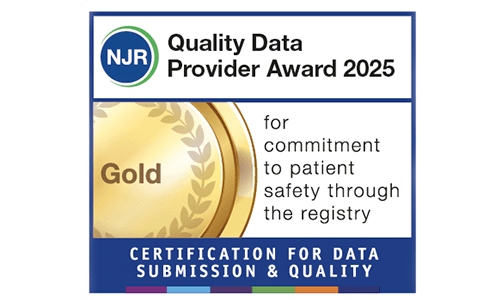Knee pain is common and can result from injury, overuse, or conditions like arthritis. Treatment varies based on the cause and may include rest, exercise, medication, or surgery. Early care can help ease pain and support recovery.
What is knee pain?
Knee pain is a widespread issue and ranks as the second most common musculoskeletal complaint in adults, following back pain1. It can affect people of all ages and often results from injury, strain, or underlying health conditions like arthritis. Osteoarthritis knee is the most common cause of knee pain in those over the age of 451.
Pain in your knee may be felt in different parts of the joint - front, back, sides, or deep within, and can range from mild discomfort to severe pain that impacts mobility. This pain may be accompanied by symptoms such as stiffness, swelling, redness and warmth, weakness and instability, or difficulty straightening your knee.
Knee joint pain can often be treated at home. It should start to feel better in a few days but if not, it’s advisable for you to see a doctor. You should seek medical attention if you experience severe pain, swelling, or instability in your knee, difficulty bearing weight or moving your knee fully, visible deformities in your leg or knee, fever with redness, pain, and swelling, or knee pain linked to an injury.
What causes knee pain?
Understanding knee pain causes is essential for determining the best treatment approach. If knee pain affects your daily activities or worsens over time, you should seek medical advice to help manage and improve your knee pain.
Knee pain in ladies is more common due to hormonal influences, joint alignment, and muscle imbalances. Women are more likely to experience conditions such as patellofemoral pain syndrome, ACL injuries, and osteoarthritis.
Injury
Knee injuries can result from sudden trauma, accidents, or sports-related movements, leading to significant knee pain, swelling, and restricted mobility. Common types include:
- ACL tears – the anterior cruciate ligament (ACL) stabilises your knee. ACL tears often occur during sudden stops, pivots, or direct impacts, causing instability, swelling, and difficulty bearing weight.
- Meniscus tears – the meniscus is a piece of cartilage that cushions your knee joint. Sudden twisting or excessive force can tear it, causing pain, swelling, stiffness, and sometimes a feeling that the joint is locked or can't fully move.
- Fractures – a patella (kneecap), femur, or tibia fracture can result from falls or direct trauma, causing intense pain and difficulty moving your leg.
- Knee bursitis – inflammation of the bursae, fluid-filled sacs that cushion your knee, can lead to swelling, tenderness, and pain, especially when kneeling.
- Patellar tendinitis – also called jumper’s knee, this condition results from repetitive stress on your patellar tendon, causing pain and stiffness.
- Runner’s Knee (Patellofemoral Pain Syndrome) – caused by repetitive stress on your knee joint, leading to pain around your kneecap, especially during movement.
Arthritis
Arthritis is a leading cause of chronic knee pain, affecting joint function and mobility. Common types include:
- Osteoarthritis (OA) – the most common form, an osteoarthritis knee occurs when cartilage wears down, leading to pain, stiffness, and swelling.
- Rheumatoid arthritis (RA) – an autoimmune condition that causes joint inflammation, swelling, and tenderness, often affecting both knees.
- Gout – an inflammatory arthritis caused by uric acid buildup that leads to sudden, intense pain and swelling, often affecting your knee.
Mechanical issues
Several structural issues can lead to knee pain, often affecting movement and stability. These problems may arise due to injury, muscle imbalances, or changes in gait. They include:
- Loose body – bone or cartilage fragments can break off due to injury or degeneration and float within your joint space. While often harmless, these fragments can interfere with movement.
- Iliotibial Band Syndrome – your iliotibial (IT) band runs from your hip to your outer knee. It can become tight and inflamed and rub against your thighbone. This condition commonly affects distance runners and cyclists, leading to pain and stiffness.
- Dislocated kneecap – your patella (kneecap) can shift out of place after a collision or sudden change in direction, causing pain, swelling, and difficulty moving your knee.
- Hip or foot pain – with hip or foot pai you may adjust your gait to reduce discomfort. However, this altered movement increases stress on the knee, potentially leading to pain and instability.
Sudden knee pain without injury
Experiencing sudden knee pain without a clear injury can be alarming. Common causes include conditions such as bursitis, tendinitis, gout, or the onset of osteoarthritis. Infections, overuse, or inflammation of your joint lining (synovitis) may also lead to discomfort even without trauma. Your pain may come on during rest or movement and could be accompanied by stiffness or swelling.
If your pain persists, worsens, or limits your mobility, it’s important to consult a healthcare provider to identify the cause and receive appropriate treatment.
How to tell if knee pain is muscular or in the joint
Knee pain can often be traced to either your muscles around the knee or your joint itself. Understanding where and how your pain occurs can help identify the cause:
- Muscular pain is typically felt around your knee - often pain behind your knee, in your thighs, or calves. It may feel like a deep ache or tightness, especially during or after activity. The pain usually worsens with movement and improves with rest or stretching.
- Joint-related pain tends to be felt deep within your knee and may come with stiffness, swelling, or a grinding sensation. Knee joint pain can be more noticeable when bearing weight, bending, or straightening your leg. If your pain feels like it’s coming from inside your knee or is associated with reduced mobility, your joint is likely involved.
If you're unsure or symptoms persist, it’s best to consult a healthcare provider for a proper assessment.
Knee pain treatment
Knee pain can be eased with exercise, physiotherapy, and the RICE method. Medications, both over-the-counter and prescribed, may help relieve symptoms. For severe cases, surgical options like arthroscopy or knee replacement may be considered. Always consult a healthcare professional for the right treatment.
Exercise and physiotherapy for knee pain
Gentle exercise and physiotherapy can help ease knee pain by strengthening the muscles around your knee joint, improving flexibility, and supporting proper movement.
Activities like walking, stretching, and low-impact exercises (such as swimming or cycling) may reduce stiffness and improve function. A physiotherapist can design a tailored plan of exercises for knee pain based on your needs, helping you move more comfortably and prevent further injury.
RICE method to ease knee pain
The RICE method is a simple and effective way to manage mild to moderate knee pain, especially after strain or overuse:
- Rest your knee and avoid activities that worsen pain.
- Ice the area for 15 to 20 minutes at a time to reduce swelling.
- Compress with a bandage or knee sleeve can help minimise inflammation.
- Elevate your leg helps reduce swelling by allowing fluid to drain away from your knee.
Using the RICE method early can reduce discomfort and support healing.
Medication for knee pain
Medication can be used to relieve knee pain, depending on its cause and severity.
Over-the-counter medications - such as acetaminophen or nonsteroidal anti-inflammatory drugs (NSAIDs) like ibuprofen can reduce pain and swelling.
Prescription medications - for more severe or chronic pain, a healthcare provider may recommend prescription medications, topical creams, or corticosteroid injections.
You should always consult a medical professional to find the safest and most effective treatment for your symptoms.
Knee surgery to relieve knee pain
For people with severe knee pain or damage that doesn’t improve with other treatments, surgery may be an option. Common types include:
-
Knee arthroscopy - a minimally invasive procedure to remove damaged tissue or repair cartilage.
-
Partial or total knee replacement - this osteoarthritis treatment replaces worn-out joint surfaces with artificial components.
-
Realignment surgery (osteotomy) - shifting the weight away from a damaged part of your knee.
Surgical options depend on the cause of your knee pain, age, activity level, and overall health. A specialist can help determine the most appropriate approach for long-term relief.
When to call your doctor: How to tell if knee pain is serious
While mild knee pain often improves with rest and home care, certain signs may indicate a more serious issue. Contact your doctor if you experience:
- Sudden, severe pain or swelling
- Inability to bear weight or walk
- A visible deformity or your knee gives out
- Redness, warmth, or fever (possible signs of infection)
- Pain that persists or worsens over time.
These symptoms could suggest a fracture, ligament injury, infection, or other condition that needs medical attention. Early assessment helps prevent further damage and ensures proper treatment.
How to prevent knee pain
Preventing knee pain starts with taking care of your joints during everyday activities and exercise. To protect your knees, especially during sports:
-
Warm up and stretch before physical activity to prepare your muscles and joints.
-
Wear proper footwear that provides support and cushioning.
-
Use correct technique when running, jumping, or lifting to reduce strain.
-
Strengthen the muscles around your knees - especially your thighs, hips, and core - to improve joint stability.
-
Avoid sudden increases in intensity by building up your activity level gradually.
-
Rest and recover between workouts to prevent overuse injuries.
Maintaining a healthy weight and staying active with low-impact activities like walking, swimming, or cycling can also help keep your knees strong and pain-free.
References
1 Khan, S., Logan, P. C., Asokan, A., et al. (2020) The assessment and management of the arthritic knee: an update. Available from: The Assessment and Management of the Arthritic Knee: An Update - PubMed


